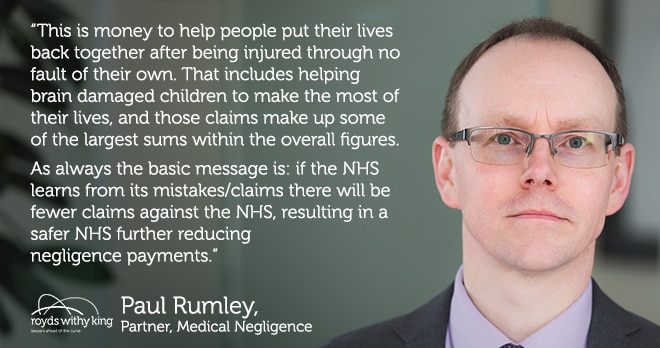Rising medical negligence costs – what is the real story?

The NHSR report, as always, needs to be treated with some caution. Figures are bandied around and taken out of context.
This is money to help people put their lives back together after being injured through no fault of their own. That includes helping brain damaged children to make the most of their lives, and those claims make up some of the largest sums within the overall figures.
It is also important to remember that these figures represent payments for negligence within the taxpayer-funded NHS. An equally important question which is often overlooked is why is there so much negligence in a system funded by us to the tune of £120bn per year, and what lessons are being learned to ensure that patient safety is improved and so the incidence of negligence is reduced? That is a conversation which, rather surprisingly, has only made it into the NHS agenda in the last 12-18 months and these sums represent claims which long pre-date that – plus of course this all needs to be seen within the picture of recent NHS scandals, such as Gosport, which would not have come to light but for people looking at what the NHS is actually doing and so holding it accountable for its actions, as claims also do.
In terms of the figures themselves - £1.63bn in damages is not all paid out at once; that represents a total sum which will be paid out over 50-60 years ie the lifetime of the claimant, and that figure has increased as a result of the Government’s own actions on how claims are calculated. The figure of £77bn is purely an insurance reserve – it represents what might need to be paid out if all notified claims are successful. They won’t be, and so realistically that figure will be very much lower than that and I would suggest no more than 30%.
The report also acknowledges that the costs of claimants are reducing and the numbers of claims is stable – not perhaps a system out of control. It also refers to the efforts being made by everyone involved in medical negligence claims – including lawyers who act on behalf of patients – to improve the system and so reduce its costs. These are the true messages from this report and any attempts to spin it otherwise has nothing to do with improving patient safety by learning from the claims patients, unfortunately, encounter through no fault of their own.
As always the basic message is: if the NHS learns from its mistakes/claims there will be fewer claims against the NHS, resulting in a safer NHS further reducing negligence payments.